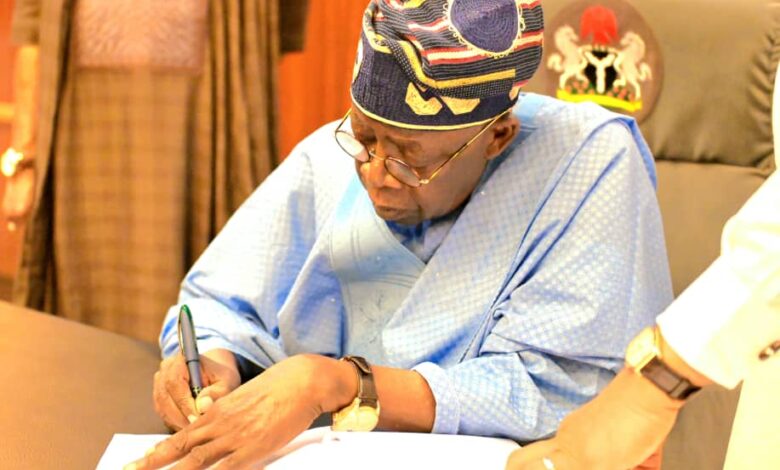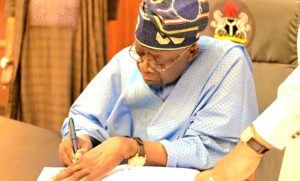
TINUBU SEEKS NASS APPROVAL FOR N1.77TN EXTERNAL BORROWING

President Bola Tinubu has written to the National Assembly, seeking approval of a fresh N1.767tn as a new external borrowing plan in the 2024 appropriation act.
If approved, the loan will be used to part-finance the deficit of N9.7tn for the 2024 budget.
The president’s request was read by the speaker during plenary on Tuesday.
The president has also forwarded the MTEF/ FSP 2025- 2027 to parliament and the National Social Investment Programme establishment amendment bill, to make the social register the primary tool for the implementation of the federal government’s social welfare programmes.
This is as the Central Bank of Nigeria recently said the Federal Government spent $3.58 billion servicing the country’s foreign debt in the first nine months of 2024.
Data sourced from the Central Bank of Nigeria (CBN) report on international payment statistics showed that the amount represents a 39.77 per cent increase from the $2.56bn spent during the same period in 2023.
According to the report, while the highest monthly debt servicing payment in 2024 occurred in May, amounting to $854.37m, the highest monthly expenditure in 2023 was $641.70m, recorded in July.
The trend in international debt servicing by the CBN highlights the rising cost of debt obligations by Nigeria.
Further breakdown of international debt figures showed that in January 2024, debt servicing costs surged by 398.89 per cent, rising to $560.52m from $112.35m in January 2023. February, however, saw a slight decline of 1.84 per cent, with payments reducing from $288.54m in 2023 to $283.22m in 2024.
March recorded a 31.04 per cent drop in payments, falling to $276.17m from $400.47m in the same period last year. April saw a significant rise of 131.77 per cent, with $215.20m paid in 2024 compared to $92.85m in 2023.
The highest debt servicing payment occurred in May 2024, when $854.37m was spent, reflecting a 286.52 per cent increase compared to $221.05m in May 2023. June, on the other hand, saw a 6.51 per cent decline, with $50.82m paid in 2024, down from $54.36m in 2023.
July 2024 recorded a 15.48 per cent reduction, with payments dropping to $542.50m from $641.70m in July 2023. In August, there was another decline of 9.69 per cent, as $279.95m was paid compared to $309.96m in 2023. However, September 2024 saw a 17.49 per cent increase, with payments rising to $515.81m from $439.06m in the same month last year.
Given rising exchange rates, the data raises concerns about the growing pressure of Nigeria’s foreign debt obligations.
On Monday, Channels Television reported a rise in debts of the 36 states of the federation.
The total debts of the 36 states in Nigeria rose to N11.47tn as of June 30, 2024, despite allocations by the Federal Accounts Allocation Committee (FAAC), and their respective internally generated revenues (IGR).
An analysis of data from the public debt reports released by the Debt Management Office (DMO) said the rise was 14.57 per cent higher than the N10.01tn recorded in December 2023.
External debt for the states and the Federal Capital Territory also climbed from $4.61bn to $4.89bn within the period under review.
In naira terms, the debts increased by 73.46 per cent, from N4.15tn to N7.2tn, following the devaluation of the naira from N899.39/$1 in December 2023 to N1,470.19/$1 by June 2024.
However, domestic debt for states and the FCT declined from N5.86tn to N4.27tn.
In total, states and the FCT accounted for Nigeria’s public debt of N134.3tn in June 2024, a decrease from their 10.29 per cent share in December 2023, even as their nominal debt levels increased.
It was earlier reported that the sub-national governments continued to grapple with a persistent reliance on borrowing to finance their budgets in 2023, as the total debt stock of the 36 states surged by 38.1%, from N7.25tn in 2022 to N10.01tn.
According to BudgIT’s 2024 State of States report released on Tuesday, the debt growth was partly driven by a N606.12bn increase in domestic debt, resulting in an average year-on-year growth rate of 11.4%. By 31st December 2023.
The total domestic debt stood at N5.86tn.
The situation was further complicated by rising foreign debt, which increased by 4.1%, from $4.43bn in 2022 to $4.61bn in 2023.
According to the report, the liberalisation of the exchange rate exacerbated the financial strain on states, significantly raising their foreign loan repayment obligations in naira terms.
Lagos State remained the most indebted in foreign currency, accounting for 26.9% of the total foreign debt, equivalent to $1.24bn.
The DMO’s report comes after BudgIT’s report said that the 32 states of the federation relied on FAAC for at least 55 per cent of their total revenue in 2023.
According to the 2024 report released last week, the development paints the over-reliance of state governments on federally distributable revenue and accentuates the vulnerability of the state governments to crude oil-induced shocks and other external shocks.
The report further said that 14 states relied on FAAC receipts for at least 70 per cent of their total revenue. Furthermore, transfers to states from the federation account comprised at least 62 per cent of the recurrent revenue of 34 states, except Lagos and Ogun, while 21 states relied on federal transfers for at least 80 per cent of their recurrent revenue.
In the 2023 fiscal year, the combined revenue of all 36 states in Nigeria increased significantly by 31.2 per cent from N6.6tn in 2022 to N8.66tn.
This growth rate exceeded the previous year’s increase of 28.95 per cent, indicating a notable improvement in fiscal performance.
Of the total revenue generated in 2023, Lagos State contributed N1.24tn, representing 14.32 per cent of the cumulative revenue of the 36 States.
Gross FAAC, which grew by 33.19 per cent from N4.05tn in 2022 to N5.4tn in 2023, contributed to 65 per cent of the year-on-year growth of the combined revenue of the 36 states.
“32 states relied on FAAC receipts for at least 55 per cent of their total revenue, while 14 states relied on FAAC receipts for at least 70 per cent of their total revenue.
“Furthermore, transfers to states from the federation account comprised at least 62 per cent of the recurrent revenue of 34 states, except Lagos and Ogun, while 21 states relied on federal transfers for at least 80 per cent of their recurrent revenue.
“The picture painted above buttresses the over-reliance of the state governments on federally distributable revenue and accentuates their vulnerability to crude oil-induced shocks and other external shocks.”
The report provides a detailed analysis of states’ fiscal sustainability, examining how well they balance internally generated revenue against federal allocations.
